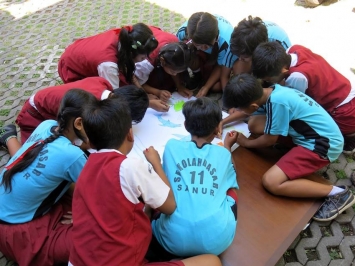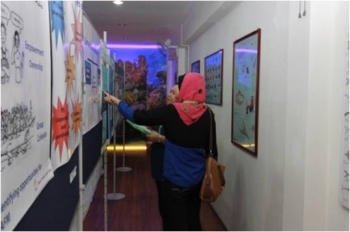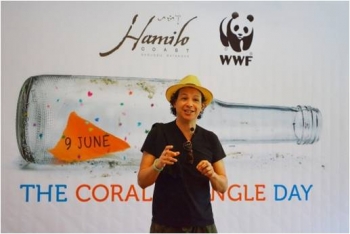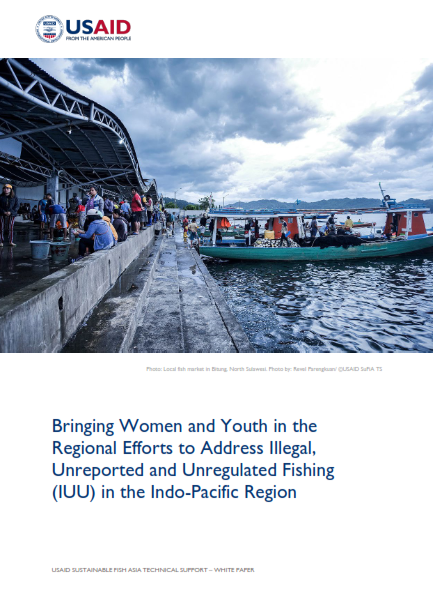Stories of the Coral Triangle Day 2014
More and more, the six CTI-CFF Member-States are taking ownership of The Coral Triangle Day, which has become a month-long celebration for some countries. As of the time of this posting, partial reports on the celebrations say that this year’s celebrations started as early as May 30 and included at least 36 activities involving thousands of participants across the Coral Triangle region, including Fiji.
Reports from Indonesia say The CT Day was celebrated in at least Bali, Makassar, and Jakarta, with the bigger events involving some 1,000 people.
Malaysia reported at least three major events, including a sustainable seafood festival, a month-long sustainable seafood “selfie contest” and an exhibit and other activities organized by Universiti Malaysia Sabah in the latter part of June.
In Papua New Guinea, the celebration included at least one mangrove planting activity involving students and teachers from the University of Papua New Guinea.
In the Philippines, dozens of activities were conducted throughout the month by various organizations in several towns and cities, including a number that were initiated by the private sector.
In Solomon Islands, activities were held on June 8 to celebrate World Oceans Day and as a prelude to The CT Day, as well as on The CT Day itself.
And, in Timor-Leste, more than 100 people showed up for a beach and underwater clean-up organized by Conservation International.
Below are four stories published in four countries to commemorate The CT Day 2014. For more snippets and images, visit The CT Day 2014 Photo Galleries.
Indonesia: Children Celebrate Coral Triangle Day with Fun
Malaysia: Wave to the Ocean and It Will Wave Back
Philippines: International chef Bobby Chinn promotes sustainable seafood
Solomon Islands: The Last Journey Home
Indonesia: Children Celebrate Coral Triangle Day with Fun
By Desy Nurhayati, Bali Daily Denpasar, June 11, 2014

CT Day means fun and learning for these schoolchildren participating in CTC’s
Open House in Bali, Indonesia (Courtesy: CTC)
AS the world celebrated Coral Triangle Day on Monday, the Coral Triangle Center (CTC) held an open house for schoolchildren in Sanur to raise awareness of the importance of conserving marine environments.
The celebration brought together schoolchildren, parents and local youth from around Sanur to participate in classes and games about marine conservation and sustainable fishing. The children were introduced to coral reefs, mangroves, seagrass ecosystems and the species living in those habitats.
Among the highlighted issues was the importance of marine ecosystems for the livelihoods of people, as well as the connectivity between the ecosystems, such as through fish migration. In a group drawing competition, the children illustrated their own interpretation of the species and habitats that are part of the marine ecosystems. Around 50 children and students took part in the games, which were followed by a prize ceremony and lunch.
“We engage schoolchildren and then introduce them to the basics of marine conservation, so they can share what they learned with their friends and family and take action,” CTC Executive Director Ril Djohani said.(To view source article, click here [external link])
Malaysia: Wave to the Ocean and It Will Wave Back
By Des Iskandar, Malaysian Digest, 11 June 2014

A marine-themed exhibit by Universiti Malaysia Sabah to celebrate CT Day
and World Oceans Day
This year, World Oceans Day was jointly celebrated with the Coral Triangle Day, based on the common theme "Together we have the power to protect the Ocean!".
The Minister of Science, Technology and Innovation of Malaysia, Datuk Dr. Ewon Ebin, said that since 2011, Malaysia has joined fellow maritime nations under UNESCO in celebrating World Oceans Day..
"To date, MOSTI (Ministry of Science, Technology and Innovation of Malaysia) has approved and is monitoring 56 research projects related to the ocean that involves a total funding of RM15.71 million," he said.
"Malaysia is also involved in various programs or initiatives on the conservation of the marine ecosystem such as the Coral Triangle Initiative (CTI), the Sulu Sulawesi Marine Ecoregion (SSME) and the Bay of Bengal Large Marine Ecosystem (BOBLME)," he further elaborated. (To view source article, click here)
Philippines: International chef Bobby Chinn promotes sustainable seafood

Celebrity chef Bobby Chinn pitches sustainable seafood
(Courtesy: Gregg Yan/WWF)
09 June 2014, By WWF -- WHERE does the fish on your plate come from? It is highly likely that it was sourced from the Coral Triangle, the world’s epicenter of marine life and abundance.
Every day, thousands of small fishing boats set out within this throbbing nursery of the seas, whose resources directly sustain the lives of more than 120 million people. However, unsustainable fishing methods have shattered coral reefs and depleted fish populations all over the region.
More than 85% of the reefs in the Coral Triangle – which spans the waters of the Philippines, Indonesia, Malaysia, Papua New Guinea, the Solomon Islands and Timor-Leste – are directly threatened by local human activities, substantially more than the global average of 60%. Asia’s growing population coupled with an insatiable appetite for dwindling delicacies like shark fin soup is placing extreme pressure on our seas.
Overfishing and illegal fishing are threatening coastal and marine environments, wiping out large populations of fish stocks and compromising people’s food security and livelihoods. Pacific Bluefin Tuna (Thunnus orientalis) stocks for example, are taking a nosedive. The International Scientific Committee for Tuna and Tuna-like Species in the North Pacific Ocean (ISC) says that the global population has shrunk by 96.4% compared to unfished levels.
To promote better alternatives and viable solutions that protect the region’s marine wealth, the World Wide Fund for Nature (WWF), Costa del Hamilo, Inc. (Hamilo Coast), plus international celebrity chef Bobby Chinn partnered to celebrate Coral Triangle Day in the Philippines on 9 June 2014.
“As seafood consumers, we all have a responsibility to ensure that the fish we eat comes from sustainable sources or were caught in ways that aren’t harmful to the marine environment. This helps conserve our food supply and the livelihoods of millions of people who depend on the ocean’s bounty,” said Chinn, a Vietnam-based chef, restaurateur, and television personality. He previously marked the Coral Triangle Day in Indonesia and Malaysia.
Now on its third year, the Coral Triangle Day is an annual open-sourced event celebrated in the countries belonging to the region every 9 June. The festivities are done in conjunction with World Oceans Day, which is celebrated every year on 8 June.
Set against the majestic blue waters and lush landscapes of Pico de Loro Cove in Nasugbu, Batangas, Chinn kicked off his cooking segment by cooking Yellowfin Tuna (Thunnus albacares) sourced by hand-line from Occidental Mindoro. Hand-line is a traditional and more sustainable way of catching tuna, several stocks of which are threatened in the Coral Triangle.
To promote local fisheries, Chinn prepared dishes from local fish sourced off the waters of Hamilo Coast.
Lastly, to raise awareness about the perils of shark finning, Chinn created a seared snapper head dish with dipping sauce, as an alternative to shark fin soup. About 73 million sharks are slaughtered each year for the lucrative shark fin trade. This high demand for shark fin soup, particularly in China and Hong Kong, threatens the health and balance of global marine ecosystems.
“The worldwide demand for tuna, live reef fish, and other marine products continues to grow – at a frightening environmental cost to the Coral Triangle. Through our partnership with Bobby Chinn and Hamilo Coast in celebrating Coral Triangle Day, we hope to emphasize the need to rehabilitate the Coral Triangle’s reefs from decades of damage and build a sustainable means of livelihood for fishermen,” says WWF-Philippines Vice President for Conservation Programs Joel Palma.
Concludes Costa del Hamilo, Inc. Senior Vice-President for Operations Rona Torres-Tan, “Preserving the Coral Triangle is a cause that is important to us because Hamilo Coast is located right at the entry of the Verde Island Passage, one of the most prolific areas of the Coral Triangle. As stewards of this one-of-a-kind location, we, along with our community of homeowners and club members, are committed to protecting the gifts of nature that Hamilo Coast has been blessed with, for years to come.”
Solomon Islands: The Last Journey Home
By: Ken Lewis (TNC) and Lysa Wini (CTI), June 9, 2014 (as published in Solomon Star, reposted with the authors’ permission)
Local rangers trained to monitor turtles at Arnavon Islands (Courtesy: TNC)
IN 2007, a Leatherback turtle swam from California to Isabel Province in the Solomon Islands. It was returning from a beach in Haevo where it was born to lay its own clutch of eggs. It was the last journey it ever made. Hunters found the turtle and killed her.
We know this because a satellite tracking device was attached to its leathery back by NOAA, a US-based Research Organization. The device tracked the Leatherback as it swam across the world’s biggest ocean. It tracked it all the way to the Solomon Islands and to the beach where it died. Even though the turtle was dead and its body long gone, the beacon kept sending its signal and was tracked to the home of one of the hunters.
“The story of that Leatherback in Haevo shows just how amazing these turtles are,” says Willie Atu, Solomon Islands programme director at TNC.
“That turtle travelled over 12,000 km across the Pacific to the very same beach it hatched on. Turtles often live for 100 years or more so that turtle had probably seen more than the man who killed it. But what the Haevo turtle story really tells me is that what we do as individuals has a real impact on the world around us and, in this case, on the precious marine life we Solomon Islanders rely on.”
Turtles have existed for more than 200 million years – they existed even before the dinosaurs. But these graceful swimmers are now listed as seriously endangered. Turtles are just one creature under threat on land and in our oceans, however we see them as a kind of barometer, explains Willie Atu. “By protecting our turtles, we are also protecting our reefs, our fish stocks and our own livelihoods.”
Regardless of where you live in the world, it is quite likely that an invisible bond ties you to 6 million square kilometres of seas in the Asia-Pacific region that is bursting with marine life. This is the Coral Triangle and it stretches from the Philippines down through Malaysia to Papua New Guinea and then across to the Solomon Islands.
Imagine a spectacular marine ecosystem covering just 1 percent of the planet’s surface that is also home to an incredible ….76%*(?) percent of the world’s coral reef species! This is where six of the world’s seven marine turtle species (Loggerhead, Green, Hawksbill, Kemp’s Ridley, Olive Ridley, Flatback and Leatherback) nest, forage and migrate.
In the Solomon Islands alone, we have five of those turtle species – three of which nest here. Joining them in our beautiful waters are whales, dolphins, rays, sharks, dugongs, and the world’s largest fish – the whale shark. All of these species thrive in the Coral Triangle, delighting locals and tourists alike. But the Coral Triangle is more than a source of wonder. It is also a biological powerhouse that feeds millions of people, sustains countless jobs and livelihoods, drives thousands of businesses and fuels economies around the globe.
To name just one obvious example, the Coral Triangle is where an increasing share of the world’s tuna supply is caught. Shipped in cans or iceboxes, that tuna in your sandwich, salad or sushi could well have been caught in this small but incredibly bountiful pocket of the ocean. That abundance may also be its downfall. Sadly, irresponsible fishing and land use practices are pushing our ocean systems to the point of collapse, threatening the survival of present and future generations. On top of that we have ocean warming and acidification – both effects of climate change.
In the Solomon Islands, we have experienced some of the highest climate-change related warming and sea level rise in the world with a 16cm increase in mean sea levels recorded since 1996. Currently, sea levels are rising by 8-10mm per year in the region. The global average is 3mm per year.
Acting locally for global impacts is a huge problem and you can be forgiven for feeling there is not much you can do as an individual to stop global warming and sea level rise, or to roll back tuna fishing fleets.
The same beaches our roaming California leatherback came ashore on for the very last time were last year declared off limits to hunters by 11 communities. The Haevo Khulano Integrated Conservation Area Management Committee also protected its reefs from overfishing.
Seeing 11 communities put aside their differences and protect their resources shows how far attitudes have changed. The people of Haevo were inspired by the success of the Arnavon Islands, a group of atolls between the provinces of Choiseul and Isabel where hawksbill turtle nests have increased 200 percent since three communities came together to protect the atolls in 1995. In both cases, TNC helped communities to create the protected areas. Atu agrees that there is a lot more to the Coral Triangle than turtles. “But for us, turtles are a strong symbol of our cultural connections. That’s why we encourage people to think about turtles and to consider what the world would be like without them. If we can’t save such an ancient and majestic creature, how can we hope to save ourselves?”
The Permanent Secretary of the Ministry of Environment, Climate Change, Disaster Management and Meteorology (MECDM), Dr. Melchior Malaki, congratulates the communities in Haevo, Isabel Province for taking the responsibility to protect the nesting grounds of the leatherback turtles in Haevo. He remarked, “the responsibility to protect, manage and conserve our natural resources lies solely on the shoulders of our communities, our local communities are integral part of any management decision as they own and use these resources daily. Therefore, protecting our Coral Triangle begin with communities making such decisions and actions. The Government’s role is to support these communities. Only our local communities can make the difference in ensuring our present and future generation enjoy the benefits of this spectacular marine ecosystem we call our home.”



